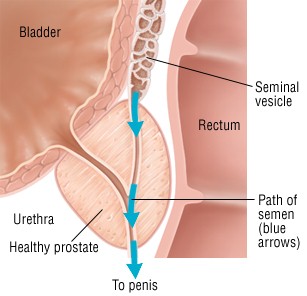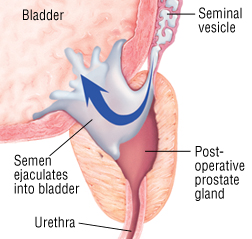Introduction
Retrograde ejaculation occurs when semen enters the bladder instead of emerging through the penis when a man has an orgasm. Although you still reach sexual climax, you may ejaculate very little or no semen. This is sometimes called a dry orgasm. Retrograde ejaculation does not interfere with a man’s ability to have an erection or to achieve orgasm, but it can cause infertility because the sperm cannot reach the women’s uterus. Treatment for retrograde ejaculation is generally only needed to restore fertility.
Diagnosis
In most cases, the diagnosis will be made by a primary care doctor or an urologist and a doctor who specializes in male reproductive disorders. The doctor will ask questions about your medical history, previous surgery or cancers you’ve had and current medications. In men with retrograde ejaculation, the amount of semen is decreased dramatically or there is dry climax/orgasm without semen. The doctor also will do a physical examination, which will likely include an exam of your penis, testicular and rectum. Finally the diagnosis can be confirmed by urine examination for the presence of semen after you have an orgasm. The procedure can be done at the clinic, your doctor will ask you to empty your bladder, masturbate to climax, and then provide a urine sample for laboratory analysis. If a high volume of sperm is found in your urine, you have retrograde ejaculation.
Causes

Under normal circumstances, ejaculation propels semen forward through a man’s urethra and out the tip of his penis.

In retrograde ejaculation, the muscle that shuts the bladder does not function normally. This allows all or part of the semen to travel backward (retrograde) into the bladder at the time of ejaculation. Several conditions can cause damage to the muscle that closes the bladder or to the nerves that control these muscles during ejaculation. These include:
- Surgery, such as transurethral resection of prostate, bladder neck surgery and lumbar sympathectomy.
- Side effect of certain medications used to treat high blood pressure, prostate enlargement and mood disorders
- Nerve damage caused by a medical condition, such as diabetes, multiple sclerosis or a spinal cord injury.
- Side effects of medication, may cause retrograde ejaculation include drugs to treat:
- Prostate enlargement – tamasulosin (Flomax) or terazosin ( Cardura)
- Depression – especially selective serotonin reuptake inhibitors (SSRIs) such as fluoxetine (Prozac), Sertraline (Zoloft) and several others.
- Psychosis – such as chlorpromazine (Thorazine), thioridazine (Mellaril) and risperidone (Risperdal).
Treatments and Patient Management.
Retrograde ejaculation typically doesn’t require treatment unless it interferes with fertility. In such cases, treatment depends on the underlying cause. If the condition is a side effect of medication, your doctor may be able to switch you to a different drug that does not cause the problem. In other men, all that is needed is reassurance that retrograde ejaculation is not a serious medical problem and that it is not a sign of a serious condition.
Operative measures: Some authors have described using surgery to restore antegrade ejaculation, either by fashioning a new internal sphincter after excising old scar tissue or by inserting an artificial sphincter controlled by a pump in the scrotum. The operations have shown success only for whose retrograde ejaculation is secondary to sphincter damage and it is unlikely that these techniques would work in those patients whose bladder necks are patent as a result of impaired innervation.
Drugs may work for retrograde ejaculation related to mild nerve or muscle problem involving the bladder, then your doctor will treat you with a drug, such as pseudoephedrine or imipramine (Tofranil) that improves muscle tone at the bladder entrance. This can be caused by diabetes, multiple sclerosis, certain surgeries, and other conditions and treatments. These medications help keep the bladder neck muscle closed during ejaculation. . While they’re often an effective treatment for retrograde ejaculation, all of these medications can cause side effects. Some of the side effects are minor, but others can be more serious:
- Some medications used to treat retrograde ejaculation can cause serious reactions when combined with other medications.
- Certain medications used to treat retrograde ejaculation can increase your blood pressure and heart rate, which can be dangerous if you have high blood pressure or heart disease.
Infertility
Failures of medical treatment or retrograde ejaculation due to anatomical causes are indications for sperm retrieval for use with assisted conception methods.
If you have retrograde ejaculation, you’ll likely need treatment to get your partner pregnant. In order to achieve a pregnancy, a fertility specialist may be able to help. The fertility specialist may collect sperm from your urine and used washed sperm for an assisted-fertilization procedure. It is important to ensure dilute alkaline urine for better sperm survival. The ideal pH for the specimen should be in the range of 7.5 – 8.5. You will need to take oral sodium bicarbonate 600 mg, 4 times per day beginning 2 days prior to sperm collection. The doctor also will advised you to drink 300 ml of water, 1 hr prior to ejaculation and then asked to first void to completion, ejaculate, and next void to completion as soon as possible after ejaculation. The post –ejaculation urine is spin down and the sperm pellet examined and processed. Depending on the count and quality of sperm collected, three of the commonly used assisted fertilization procedures are:
- Intrauterine insemination (using a small catheter to put washed sperm inside your partner’s uterus at the time of ovulation)
- In-vitro fertilization ( incubating eggs and sperm together in the laboratory to produce fertilization)
- Intracytoplasmic sperm injection (injecting a single sperm into your partner’s egg to cause fertilization)
If it is not possible to retrieve viable sperm from urine then the last resort of surgical sperm retrieval directly from the testis or epididymis, followed by intracytoplasmic sperm injection can be used.
References
- Khaldoun Sharif. Advances in the treatment of male infertility. Recent Advances in Obstetrics and Gynaecology. 2001 : 11: 141 -159
- James D. M. Nicopoullos, Jonathan W. A. Ramsay Carole Gilling-Smith. Assessment and management of azoospermia in the infertile couple. Progress in Obstetrics and Gynaecology 2005. 15. 241-257
- Thomas R Aust, D Iwan Lewis-Jones. Retrograde ejaculation and male infertility. Hospital Medicine. 2004, vol 65, 6. 361 – 364
| Last Reviewed | : | 14 April 2016 |
| Writer | : | Dr. Mohd Nasir Tak Abdullah |
| Accreditor | : | Dr. Wan Abu Bakar bin Yusof |







